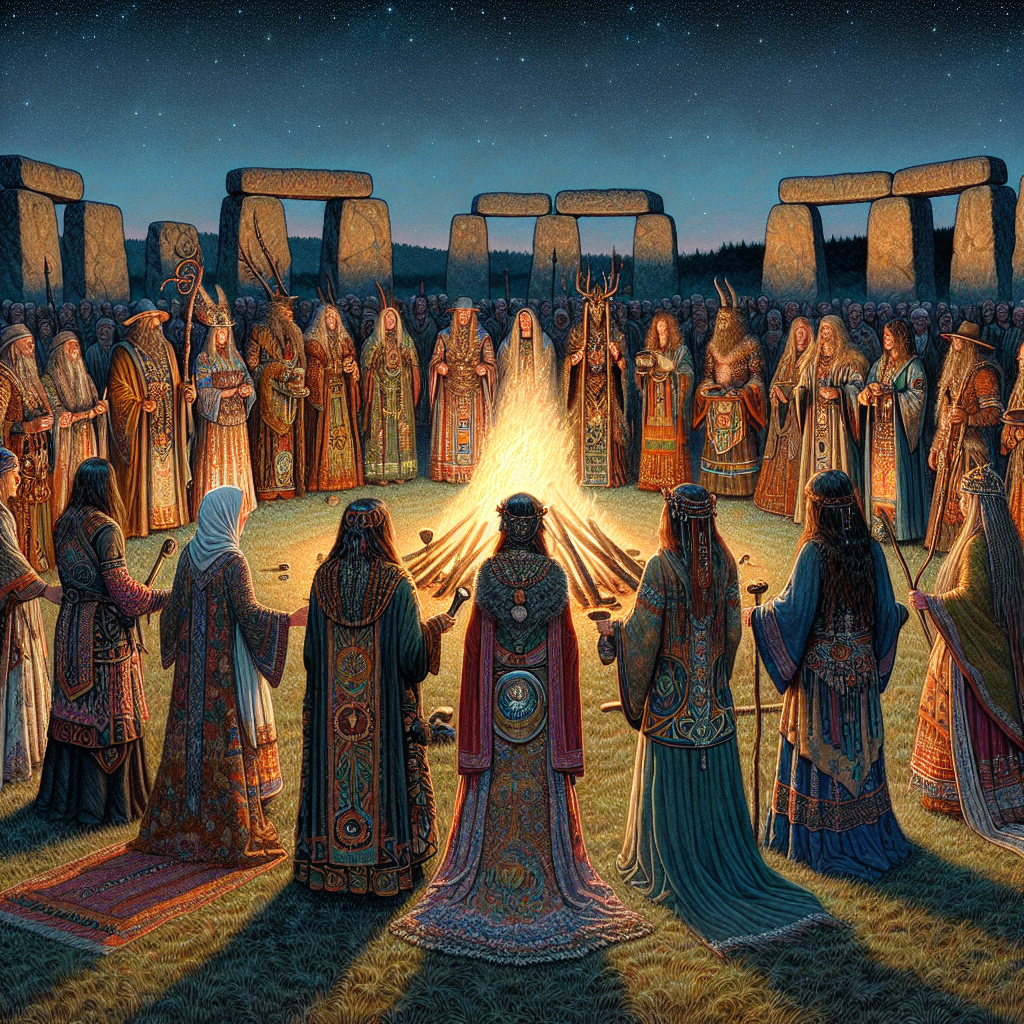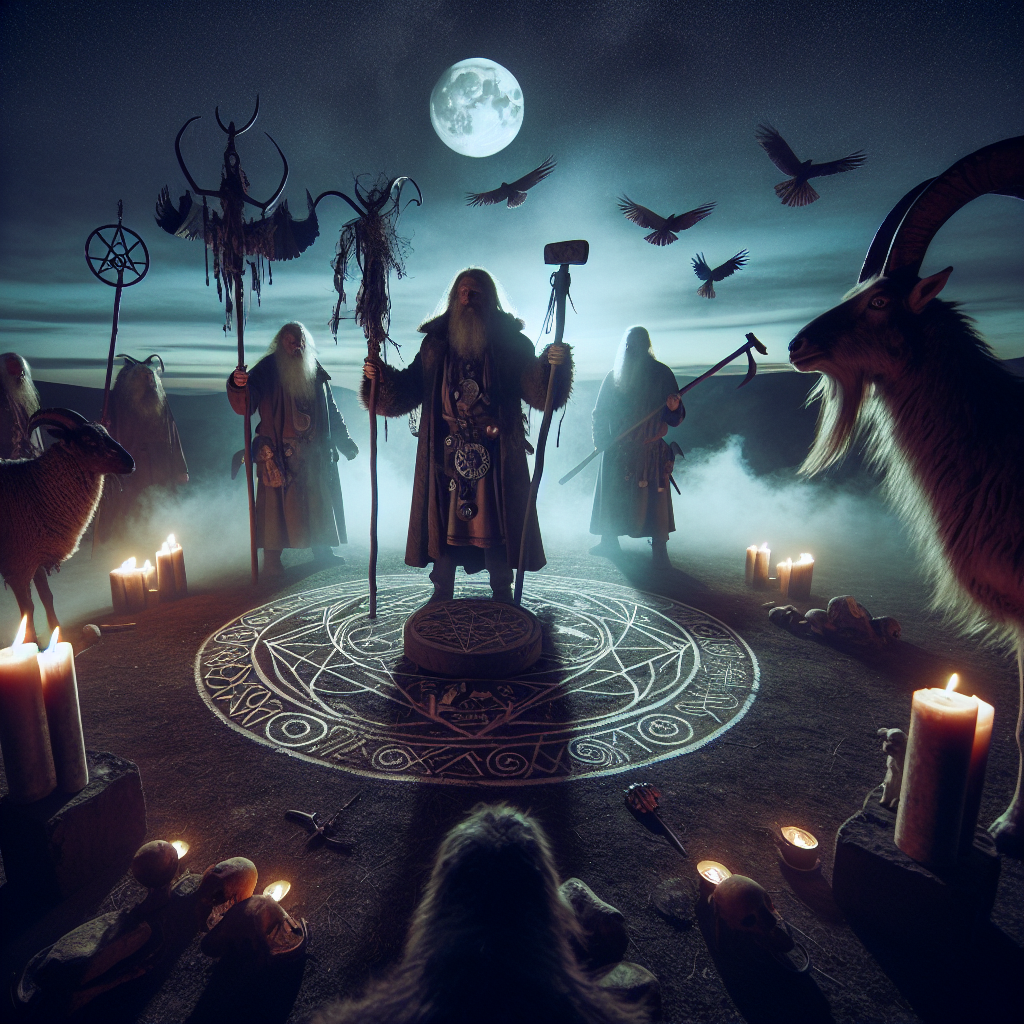As an Amazon Associate I earn from qualifying purchases.
Contrary to popular belief, ancient pagan practices are no longer confined to the pages of history books or small pockets of devotees in hidden corners of the world. Instead, driven by increasing global spiritual and wellness trends, a revival of ancient pagan rituals has been observed in recent years, bringing back the fascinating worlds of old-world magic and spirituality.
Ancient pagan rituals draw from pre-Christian cultures, and include a vast array of different traditions spanning Europe, Northern Africa, and the Middle East. There’s a common thread in these traditions, though: a profound respect for the natural world, and the belief in the interconnectedness of all living beings. Whether it’s ancient Druidism, Nordic shamanism, or Greco-Roman mystery cults, these early pagan practices place an emphasis on the cyclical pattern of the seasons, and the forces of nature.
The rediscovery of these ancient practices resonates with many who feel disillusioned by conventional religious frameworks or the disconnection often fostered by urban living. With its emphasis on interconnectedness and the natural world, paganism provides a spiritual path that engenders a deep sense of belonging and unity with the environment.
This revival can be seen not only in increased interest in pagan holidays and festivals, such as the summer solstice celebration of Litha or the wintertime festivity of Yule, but also in the growth of cottage industries providing pagan-inspired crafts, healing remedies, and divination tools. Data from the American Religious Identification Survey (ARIS) suggests a significant rise in people identifying as pagan, from 140,000 in 2001 to 340,000 in 2008.
There’s also an explorative element within the practice of ancient pagan rituals, inviting individuals to develop their craft according to personal beliefs and feelings. Rituals range from simple, solitary acts like meditating under a full moon, to more elaborate group ceremonies such as the celebration of Ostara, a festival welcoming the arrival of Spring, that involves feasts, music, and sometimes even theatrical performances.
Interestingly, there is an increasing adoption of pagan rituals in arts, science, and even technology sectors. This can be especially seen in how artists are using pagan symbolism in their work to explore themes of nature, the divine feminine, and the cycle of life and death. Similarly, in technology circles, the principles of interconnectedness and respect for natural rhythms are being transferred to developing more sustainable and harmonious systems.
As an evolving movement, the rediscovery of ancient pagan rituals and the celebration of old-world magic continues to adapt and change according to the needs of its practitioners, breathing new life into ancient traditions while also speaking to contemporary spiritual and technological concerns.
What Are Ancient Pagan Rituals and How Can They Enhance Our Understanding of Old World Magic?
Ancient Pagan rituals refer to historical belief systems and practices from the pre-Christian era, which revolved around the veneration of nature, earthly phenomena, and multiple gods. Revisiting and understanding these rituals can enrich modern perspectives on spirituality, culture, and the human psyche. These rituals imbued a sense of harmony and order, served as a means of social cohesion, and offered solutions or solace during times of uncertainty or fears. They also provide a window into the ancient magic practices characterized by a reverence for the forces of nature, the cycle of seasons, and celestial bodies. Bearing close relevance to the Old World magic, these rituals involve practices believed to harness supernatural forces for healing, protection, prosperity, or commencing a harmonious cycle of life and death. In the subsequent sections, we delve deeper into the specific rituals, their purpose, how they were performed and their significance in celebrating old world magic.
The Revival of Ancient Pagan Rituals: An Awakening of Pre-Christian Beliefs
Recent years have seen an unprecedented upsurge in the interest surrounding ancient pagan rituals, a historic veneration of nature and celestial bodies. Originating prior to monotheistic religions, paganism was built on the concept of polytheism – the worship of multiple deities associated with different elements of nature.
Reconnecting with the Old World magic has generated a sense of fascination and curiosity as modern individuals are increasingly drawn towards finding a spiritual connection with the Earth. The series of celebrations, ceremonies, and rituals that unfold throughout the year provide an elevated degree of spiritual credibility and personal fulfilment to those who choose to participate in these rituals.
Key Rituals and Their Significance
Some of the common ancient pagan rituals include celebrating solstices, equinoxes, and other annually occurring natural phenomena. Among these, the equinoxes and solstices are of central importance, representing crucial points in the cycles of fertility and renewal.
For instance, Yule or the Winter Solstice, is one of the most important pagan rituals. The ceremony is characteristically lit by candles and bonfires, symbolising the rebirth of the sun. The celebration often includes feasting on traditional foods and singing songs of worship.
Similarly, the Summer Solstice or Litha is a festival of sun worship, observed around June 21st. This ritual is associated with abundance, and it includes activities such as lighting large bonfires, dancing, and making offerings of fruits to the sun god.
Another vital ritual is Beltane, celebrated on May 1st; it signals the commencement of summer. During this festival, larger-than-life Maypole dances are performed, symbolizing the entwining of the God and Goddess, an act which is believed to generate life-force energy.
The Rising Popularity of Paganism
The rediscovery and re-embracing of ancient pagan rituals have been attributed to growing disillusionment with the stringent doctrines of monotheistic religions, and an increasing yearning to reconnect with nature. Paganism, with its focus on celebrating the Earth, its cycles, and its bounty, offers an enticing model of spirituality.
Moreover, the rituals provide solace to individuals seeking a more grounded, tangible way to connect with the universe. They allow participants to tap into a reservoir of mysticism, releasing cathartic energies and grounding individuals in the present moment.
Modern paganism, also known as neopaganism, is not confined to a specific region or culture. From Wicca in the UK to Asatru in Scandinavia, or Celtic paganism in Ireland, all these varying forms of revived paganism are enjoying renewed interest and participation.
As a marker of the embrace of ancient rites, the Pew Research Center’s study in 2014 found that about 1% of Americans identified as Pagans or Wiccans, a significant increase compared to previous decades. This number is likely to continue to rise as more individuals become familiar with the intuitive wisdom offered by the ancient pagan rituals, and explore these age-old traditions afresh.
1.
What are ancient pagan rituals?
Ancient pagan rituals are ceremonies, celebrations, or rites that were practiced by ancient peoples who worshiped multiple deities, often associated with natural elements and forces. These rituals could encompass a variety of activities, such as sacrifices, offerings, dances, festivals, or communal meals, all with the purpose of honoring and appeasing the gods.
2.
Are pagan rituals only associated with specific cultures or regions?
No, pagan rituals aren’t exclusive to a specific culture or region. Paganism was a worldwide phenomenon. Each culture and region had its own pantheon of gods, practices, and rituals. This means that pagan rituals can vary greatly depending on the geographical area and the specific culture.
3.
Why are ancient pagan rituals being rediscovered?
Ancient pagan rituals are being rediscovered for a number of reasons. As people seek out alternatives to mainstream religious practices, many are attracted to the direct connection with nature and the spiritual world that pagan rituals offer. Additionally, scholars and historians are continually uncovering new information about these practices, further fueling interest and exploration.
4.
Are there any risks or dangers associated with practicing ancient pagan rituals?
As with any spiritual practices, the risks depend largely on how one approaches the process. It’s important to respect the ritual and its roots, not going beyond one’s capacity or understanding. Involving experts or experienced practitioners can greatly reduce potential risks. However, there are no inherent dangers in the rituals themselves.
5.
How can I learn about and participate in ancient pagan rituals?
Books, scholarly articles, and online resources can provide valuable insight into ancient pagan rituals. For hands-on experience, consider joining a local or online pagan community. These organizations often offer classes, workshops, and opportunities to participate in organized rituals.
6.
What does the term “Old World Magic” refer to?
Old World Magic” refers to the spiritual practices and beliefs that pre-date modern religions. It’s often associated with pagan, shamanic, or folk traditions, where the emphasis is on a direct and personal experience of the divine, often through nature and natural phenomena.
7.
Are ancient pagan rituals connected to witchcraft?
While there is some overlap, they are not inherently the same. Not all pagan rituals have ties to witchcraft, and not all witchcraft practices are pagan in nature. However, both share an appreciation for nature and its spirits and forces.
8.
Can ancient pagan rituals coexist with modern religions?
Absolutely. Many people incorporate aspects of ancient pagan rituals into their current religious practices to enhance their spiritual experience. However, it must be done with an understanding and respect for both traditions.
9.
Is there a set of beliefs or doctrine associated with practicing ancient pagan rituals?
Ancient pagan practices are incredibly diverse, and it’s difficult to establish a universally accepted doctrine or set of beliefs. However, a common thread among many pagan practices is reverence for nature and the environment, and a belief in the immanence of divinity.
10.
Are these rediscovered ancient pagan rituals authentic?
While the authenticity of rediscovered pagan rituals can vary, most are based on historical texts, archaeological findings, and other scholarly works. However, due to the fragmented nature of historical records, there may be some degree of interpretation or adaptation involved in their modern applications.

Conclusion: Embracing the Resurgence of Ancient Pagan Rituals
In essence, the rediscovery and resurgence of ancient pagan rituals is not merely an isolated phenomenon, but rather a reflection of contemporary society’s increasing fascination with old world magic and spiritual customs. These rituals, which are steeped in an intricate blend of mythology, folklore, and natural symbolism, offer an alternative spiritual pathway that is intrinsically tied to the rhythms of the natural world. From the celebration of the cycles of the moon to the practices of divination, ancestral reverence, and elemental worship, each ritual captures a distinct facet of human interaction with the cosmos. The return to these practices signifies a longing for spiritual authenticity and connection with Mother Earth, elements often seen as lost in modern religion and lifestyle.
Understanding and appreciating the rich complexity of these rituals require a willingness to immerse oneself in a tradition that predates written history. As we respect the spiritual underpinnings of these practices, we also encounter a deep well of wisdom that challenges our perceptions of the divine. These ancient pagan rituals, through their palpable ties to nature and the cosmos, beckon us to rediscover the sacred magic in the everyday and reestablish our bond with the natural world, urging us towards a more harmonious and balanced lifestyle. Rediscovering ancient pagan rituals is not simply revisiting the past, but also seeking to build a more inclusive, diverse and balanced spiritual future.
Amazon and the Amazon logo are trademarks of Amazon.com, Inc, or its affiliates.


